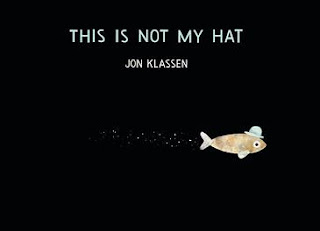
Bibliography
Klassen, Jon. THIS IS NOT MY HAT. Massachusetts: The Candlewick Press, 2012. ISBN9780763655990.
Plot Summary
The little fish has some nerve to steal and brag about taking the big fish's hat. The big fish didn't notice his hat was missing since he is too busy slumbering. The little fish proceeds to swim to the place where the plants are big and tall and where no one can find him. He even goes on to say how someone saw him heading into the tall weeds and he feels assured they will not tell the big fish. His luck runs out when the big fish is close on his tail and finds him in the big and tall plants. The big fish comes out of the big and tall plants with his hat on and as content as can be. Too bad the little fish is nowhere to be seen!
Critical Analysis
Talk about a good reason why you should not take what is not yours or steal. The lesson learned is that there can be some major consequences to your actions...so be careful, very carful with the choices you make. The author did an amazing job showing the character's expressions and feeling throughout the story. The author kept the mood intriguing and suspenseful by including short phrases and little wording. Making the audience wonder what is going to happen to the little fish.
The colors the illustrator chose also were perfect for the setting and plot of the story. The light brown and white bubbles against the black background allowed us to see the action of the swaying weeds and movement going on in the story. The black background set a suspenseful scene and kept the reader intrigued and highly interested in the story. This is a great book to make predictions and included some foreshadowing,
Great ending!!!
Awards and Review Excerpts
~2013 Caldecott Medal
~2013 Texas 2X2 Reading
~Amazon.com Review
Amazon Best Books of the Year 2012: Jon Klassen first surprised readers with his runaway best seller, I Want My Hat Back, and his follow-up, This Is Not My Hat is an inside out version that is even more fun. Not only did Klassen go with a dark color scheme where the last was light, the action takes place underwater with much of the story told through the expressive illustrations of sea creatures. From the little fish who steals a bowler hat to the crab who sells him out with eyeballs pointing the way, there are lots of laughs along with lessons. This time Klassen created an ambiguous ending that invites lively conversation about the possible outcomes and ultimately leaves it up to the child to decide the little fish's fate with every reading. --Seira Wilson ng List
~From SCHOOL LIBRARY JOURNAL
PreS-Gr 1-With this new creation, Klassen repeats the theme from I Want My Hat Back (Candlewick, 2011), but with a twist. The narrator here is the thief-a small, self-confident fish who has pilfered a little blue bowler from a big sleeping fish. He wastes no time or words in confessing his crime as he swims across the page announcing, "This hat is not mine. I just stole it." He continues his narrative with no regrets, but with a bit of rationalizing ("It was too small for him anyway.")
Connections
1. Compare and contrast the books This Is Not My Hat and Rainbow Fish. By using a double bubble map the children will be able to see the similarities and differences of these two fish.
2. Have a police officer/community helper come speak to the class about how stealing is not the best choice you can make and why.
3. Talk about the difference between borrowing, taking, buying, and stealing. Take this opportunity to discuss the meaning of the words and look for similes and antonyms.